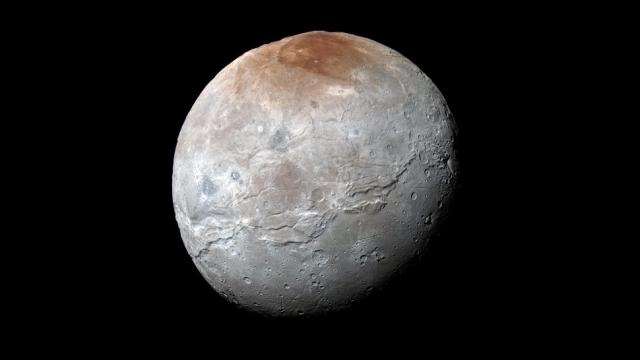Up until July 2015, Pluto’s largest Moon, Charon, was just a pixel in terms of what we knew about it. That all changed when NASA’s New Horizons spacecraft zipped through the system, revealing craters, deep crevices, valleys and mountains on the distant moon – surface features that now have formal names.
Pluto’s largest moon, Charon. Image: NASA/New Horizons
Dorothy, Butler, Kubrick and Nemo – these are a sampling of the new names given to some Charon’s most distinctive surface features, as proposed by the New Horizons team and approved by the International Astronomical Union’s Working Group for Planetary System Nomenclature. Some of the names, such as the Argo Chasma (a canyon) and Kubrick Mons (a mountain), were already in use by astronomers, but the IAU’s ruling now makes them official.

Map projection of Charon, Pluto’s largest moon. Image: NASA/New Horizons/IAU
Charon is the largest of Pluto’s five moons – it’s almost half the size of its host dwarf planet – and at about 1207km across, it’s among the largest celestial bodies in the Kuiper Belt. New Horizons came within 27,000km of Charon during its brief 2015 approach, changing what we know about it by several orders of magnitude.
Some of the names come from the IAU’s OurPluto campaign, in which people from around the world were given a chance to contribute their ideas. The 12 new names are international in scope, recognising “the spirit of human exploration, honouring travellers, explorers and scientists, pioneering journeys, and mysterious destinations,” in the words of the IAU.
Here’s the complete listing of the new names:
Argo Chasma is named for the ship sailed by Jason and the Argonauts, in the epic Latin poem Argonautica, during their quest for the Golden Fleece.
Butler Mons honours Octavia E. Butler, the first science fiction writer to win a MacArthur fellowship, and whose Xenogenesis trilogy describes humankind’s departure from Earth and subsequent return.
Caleuche Chasma is named for the mythological ghost ship that travels the seas around the small island of Chiloé, off the coast of Chile; according to legend, the Caleuche explores the coastline collecting the dead, who then live aboard it forever.
Clarke Montes honours Sir Arthur C. Clarke, the prolific science fiction writer and futurist whose novels and short stories (including 2001: A Space Odyssey) were imaginative depictions of space exploration.
Dorothy Crater recognises the protagonist in the series of children’s novels, by L. Frank Baum, that follows Dorothy Gale’s travels to and adventures in the magical world of Oz.
Kubrick Mons honours film director Stanley Kubrick, whose iconic 2001: A Space Odyssey tells the story of humanity’s evolution from tool-using hominids to space explorers and beyond.
Mandjet Chasma is named for one of the boats in Egyptian mythology that carried the sun god Ra (Re) across the sky each day – making it one of the earliest mythological examples of a vessel of space travel.
Nasreddin Crater is named for the protagonist in thousands of humorous folktales told throughout the Middle East, southern Europe and parts of Asia.
Nemo Crater is named for the captain of the Nautilus, the submarine in Jules Verne’s novels Twenty Thousand Leagues Under the Sea (1870) and The Mysterious Island (1874).
Pirx Crater is named for the main character in a series of short stories by Stanislaw Lem, who travels between the Earth, Moon and Mars.
Revati Crater is named for the main character in the Hindu epic narrative Mahabharata – widely regarded as the first in history (circa 400 BC) to include the concept of time travel.
Sadko Crater recognises the adventurer who travelled to the bottom of the sea in the medieval Russian epic Bylina.
Pretty wild to think we’re naming surface features of distant worlds, but it’s only going to get better. On 1 January 2019, New Horizons will visit Ultima Thule, the distant Kuiper Belt object also known as MU69. So get ready for some new surface features, and another batch of new names.
